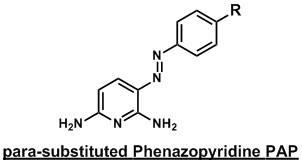Para-Substituted-Phenazopyridines (PAP) Demonstrate Enhanced Potency in Early Neuronal Differentiation of ES Cells Compared to PAP.
Embryonic stem (ES) cells are powerful tools to understand mechanisms of neuronal differentiation and to engineer neurons for in vitro studies and cell therapy. The team of Prof. Krause, University of Geneva, developed a screening approach to identify small organic molecules driving neuronal differentiation of ES cells1. Phenazopyridine (PAP) resulted as positive validated hits from the screening campaign. Phenazopyridine is a drug that is rapidly excreted into the urine and has a local analgesic effect. In a first SAR study, it was demonstrated that PAP and few analogues enhanced neuronal differentiation, increased cell survival, decreased the amount of non-neuronal and undifferentiated cells and synchronized the cellular differentiation state. In the present study aiming at expanding the SAR study and develop PAP derivatives with enhanced potency compared to PAP, we synthetized a series of 20 original analogues of PAP exploiting different approaches in the diazotation reaction2.

The para-substituted-PAPs showed up to 250 fold potency increase in early neuronal differentiation compared to PAP (EC50 = 7.7 mM). This work led to the discovery of more potent compounds that will further foster the development of differentiation protocols compatible with the generation of clinical grade neural precursors, which are able to differentiate into different neuronal subtypes, astrocytes and oligodendrocytes.
[1] Suter, D.M.; Preynat-Seauve, O.; Tirefort, D.; Feki, A.; Krause, K.H.; J. Cell Mol Med. 2009, 13(9B), 3517-27.
[2] Tardy, S; Feyeux, M; Krause, K-H; Scapozza, L. U.S. Provisional Patent Application N°.62/316,962